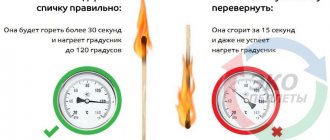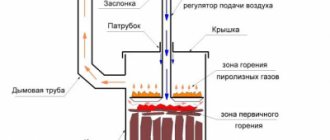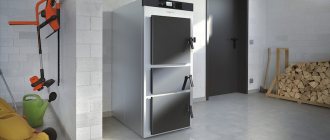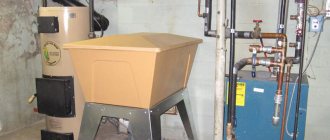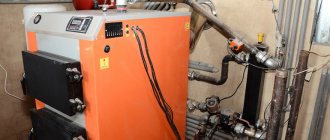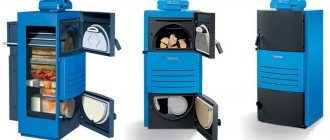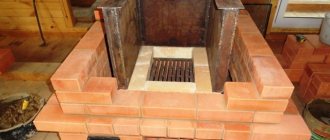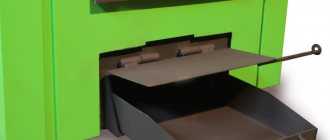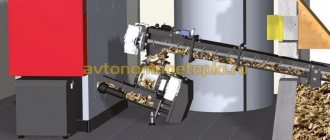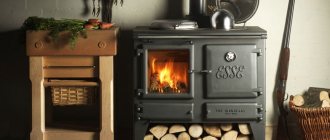Here you will learn:
Heating houses with solid fuel boilers is quite common in small settlements where there is still no gas.
In most cases, the most common firewood or fuel briquettes are used as fuel. The disadvantage of such boilers is that they force many approaches to add new portions of fuel. Long-burning pyrolysis boilers are devoid of not only this drawback, but also some others - we’ll talk about this as part of our review.
Features of pyrolysis boilers
Traditional wood-burning boilers are annoying because they require constant monitoring. That is, every 2-3 hours you need to add more and more fuel to them, otherwise the pipes in the house will become cold. It’s especially difficult at night, when instead of restful sleep, household members get a headache in the form of cooling heating. On the one hand, sleeping cool is good for your health. On the other hand, greeting the morning with your teeth chattering desperately is not very pleasant.
Classic boilers for heating a home have another important drawback - low efficiency. The fuel in them burns very quickly, most of the heat simply evaporates into the atmosphere. Along with it, combustion products containing flammable gases fly into the air. They can be used to obtain additional portions of heat - this is what happens in long-term combustion pyrolysis boilers.
As you already understand, solid fuel pyrolysis heating boilers are free from both of the above disadvantages . They are equipped with spacious fireboxes, burning solid fuel according to a slightly different principle. Here are their main features:
The operating principle of a solid fuel pyrolysis boiler is very simple. This drawing, although it does not cover all the nuances, conveys the essence of the technology in full.
- Large firebox volume – up to several tens of liters. Thanks to this, the frequency of approaches to laying fuel is reduced several times;
- Pyrolysis combustion principle - allows you to get much more thermal energy from the same amount of firewood;
- Quite large in size - in fact there are two fireboxes. In one, wood burns slowly, and in the second, combustion products released from the wood are burned;
- Low combustion temperature – reduces the thermal load on the metal.
Long-burning pyrolysis boilers are somewhat more complicated than their traditional counterparts, but they provide significant fuel savings.
Operating principle
Now we will try to understand how a long-burning pyrolysis boiler works and how it works. The principle of operation is very simple and at the same time complex. Pyrolysis is discussed in a school physics course - when heated in a confined space, wood releases flammable gases that can be set on fire to produce heat. In fact, there is no direct combustion of wood in such an experiment.
In long-burning pyrolysis boilers, wood still burns, but with limited air supply. You could say it's a slow burn. Having flared up, the tree begins to release flammable gases, which burn in the afterburner. In total, we get two sources of heat - burning wood and burning wood gas. The effect of such staged combustion is felt in the form of fuel savings of up to 40%. Wood gas in long-term combustion pyrolysis boilers is formed as a result of slow smoldering of fuel. At the same time, the equipment heats the air, which, together with wood gas, is supplied to the afterburning chamber. There the mixture ignites and burns, producing a large amount of heat. At the same time, the amount of harmful emissions, compared to traditional boilers, is extremely small.
Thus, a pyrolysis boiler is a direct saving of fuel, since a larger amount of heat can be released from the same portion of firewood. Instead of 10 cubic meters of firewood, only 6-7 cubic meters may be needed for one winter period. At the same time, users will not need to add new portions of firewood to the insatiable firebox every 2-3 hours.
Long-burning pyrolysis boilers are available in several modifications:
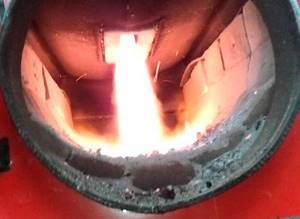
Despite the low combustion rate of the fuel, the emitted porylization gases are capable of inflating the flame to a similar bright white-yellow color.
- Non-volatile - they operate on natural draft and are controlled mechanically;
- Energy-dependent - here pyrolysis occurs using forced draft. Due to this, combustion efficiency increases;
- With different locations of the afterburning chamber - it can be located above or below the combustion chamber. Modifications with a sequential arrangement of cameras are also available for sale.
There are many modifications, but in general the device and principle of operation are almost no different.
Long-term combustion in pyrolysis boilers is ensured by two factors at once. The first factor is the low burning/smoldering rate of wood. The second factor is the large volume of the combustion chamber. For example, there are pyrolysis boilers on sale with a firebox volume of 50 liters or even more. It is not surprising that the frequency of approaches to load fuel is reduced to 1-2 times a day.
Design and principle of operation of pyrolysis boilers
Pyrolysis boiler for industrial production The operation of gas generator boilers is based on the principle of pyrolysis, which is that under the influence of high temperature with limited access to oxygen, fuel decomposes into pyrolysis gas and solid fuel residue. In the main chamber, smoldering of solid fuel occurs at temperatures reaching 800 degrees. As a result, the heat necessary to heat the coolant is released. However, if in devices with a traditional design, the gas released as a result of combustion is immediately removed through the chimney, in these devices it is mixed with oxygen, which is supplied forcibly and burns out in the second chamber. Here, additional heating of water occurs, which most often plays the role of the main coolant.
Compared to boilers operating according to the traditional scheme, gas generator boilers have a number of advantages, among which the following can be highlighted:
- High efficiency, and in some devices of this type this figure exceeds 80%, while in other devices it is usually 60-70% or even less.
- Minimum amount of harmful waste, which is facilitated by the interaction of pyrolysis gas and active carbon, which reduces the emission of harmful carbon dioxide into the atmosphere by a third.
- The versatility of pyrolysis boilers, which lies in the possibility of using various types of solid fuel, including wood, wood pellets and even sawdust.
- Easy maintenance, which consists in the fact that fuel is loaded into many gas-generating boilers no more than once a day.
- Affordable price - given the fact that the efficiency of boilers operating on the basis of pyrolysis is much higher than even traditional gas boilers, and the cost of production waste from woodworking enterprises is completely insignificant, it can be noted that the use of pyrolysis boilers can bring a tangible economic effect.
- Minimum amount of solid combustion waste - ash and soot, which facilitates boiler maintenance.
Despite this, it is worth noting that when operating pyrolysis boilers, it should be taken into account that not every fuel is suitable for their operation. In particular, wood is most often used to operate pyrolysis boilers used to heat a house. However, not all wood will be equally suitable. The essence of the pyrolysis process is to release as many flammable volatile substances as possible, and this is only possible if the wood moisture content is low - no more than 20%. Otherwise, the pyrolysis effect will not be achieved and the efficiency of such a boiler will be much lower. In addition, industrially manufactured pyrolysis boilers directly depend on the electricity required to organize the air supply. In cases where the latter is turned off, they can, at best, only work to maintain the temperature, without warming the room at all.
Advantages and disadvantages
Pyrolysis boilers have a number of advantages over their traditional counterparts. But they also have some disadvantages. Let's discuss all their pros and cons:
- Profitability - it varies from 10 to 40%, depending on the model, combustion intensity and air temperature outside the window;
- Long burning - you can add fuel only 1-2 times a day . For example, morning and evening. The house will be warm at any time of the day;
- Environmentally friendly - firewood burns almost completely, with minimal release of combustion products;
- Almost complete extraction of heat into the heating system - the temperature of the exhaust gases is lower here than in traditional boilers;
- In long-burning pyrolysis boilers, various power control mechanisms are often implemented - they work by adjusting the intensity of fuel smoldering and gas supply to the afterburner chamber.
There are also disadvantages:
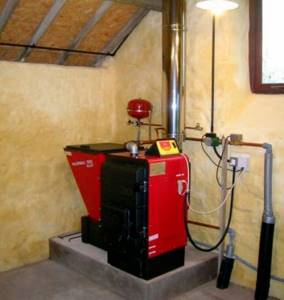
Due to its impressive dimensions, you will have to find a lot of free space to place the boiler. The basement and attic are the most promising options.
- Expensive - user reviews say that long-burning pyrolysis boilers are very convenient, economical and practical. But the initial costs of purchasing them are extremely high (most true for powerful energy-dependent models);
- Energy dependence - such units are more efficient, but require connection to the electrical network (the total electricity consumption is low, but in its absence, work will be difficult or completely impossible);
- Large dimensions - long-burning pyrolysis boilers are noticeably larger than any other solid fuel units.
Fuel used
We have already said that long-burning pyrolysis boilers operate on wood. This is a fairly common and inexpensive type of fuel. In some cases, firewood can be obtained completely free of charge. But these boilers can operate on many other types of solid fuel. For example, in some stores we can buy a pellet pyrolysis boiler. It operates on fuel pellets on the same principle as the units described above.
You can also purchase a coal-fired pyrolysis boiler. It will delight you with long burning and high efficiency. Coal boilers operate on the same principle, producing combustible gas from coal. Due to the powerful calorific value, the frequency of approaches for adding fuel is lower than when using long-burning wood-burning pyrolysis boilers.
Popular models
Next we will consider the most popular and sought-after models of long-burning solid fuel pyrolysis boilers. We will cover both non-volatile and volatile units.
Popov's boiler
Popov's pyrolysis boiler is a simple energy-independent unit made of steel. The design turned out to be so successful that many craftsmen copy it, assembling heating equipment with their own hands. The presented boiler is omnivorous; it can burn almost any solid fuel. And the impressive firebox of gigantic volume allows you to count on almost 24 hours of continuous burning. In this case, the fuel burns almost completely, forming a minimum of components harmful to nature.
One of the advantages of this pyrolysis boiler is the ability to lay logs of non-standard size (up to 75 cm in low-power models, up to 240 cm in the most productive units), which ensures long-lasting combustion. The maximum power of the equipment is 1000 kW, the minimum is only 25 kW. Depending on the selected operating mode, the efficiency of the device varies from 75 to 95%.
Geyser boilers
Equipment from the manufacturer of the same name is presented in two lines - household and industrial. Long-burning Geyser household pyrolysis boilers have a power of 10 to 50 kW. They can operate on any solid fuel, characterized by a high efficiency index. The firebox volume of the smallest model is 40 liters. The equipment is non-volatile and is characterized by extreme ease of operation and unpretentiousness.
Buderus boilers
The long-burning solid fuel pyrolysis boiler Buderus Logano G221-20 from the famous Buderus brand is an excellent purchase for heating your home. Its power is 20 kW, thanks to which it can heat rooms up to 200 square meters. m. The control here is mechanical; connection to a source of electricity is not required. The heat exchanger here is made of cast iron - this affects the cost of the model, but makes it durable and resistant to corrosion. True, the efficiency of the heating unit is only 78%.
Its closest analogue is the more advanced long-burning pyrolysis boiler Buderus Logano S171-22 W. It has a high efficiency of 87%. The use of forced draft is responsible for this - inside we will find a small fan. Another difference is the steel heat exchanger. This does not add reliability, but it does make the equipment more affordable. Average fuel consumption is about 6 kg/hour.
Boilers Bastion
Long-burning Basting pyrolysis solid fuel boilers of the M-KST series are non-volatile equipment that runs on wood and other types of solid fuel. The line has been in production for 3 years and is characterized by a low number of negative reviews. The youngest model has a power of 12 kW, the oldest – 50 kW. The boilers are equipped with powerful cast iron heat exchangers, the minimum firebox volume is 40 liters. The advantages are reliable design and affordable cost.
To heat a private house without a centralized gas supply, they mainly use accessible and inexpensive solid fuel. However, traditional types of heating devices operating on this type of fuel have rather low efficiency and are labor-intensive to operate. Long-burning boilers that appeared recently, using the pyrolysis method, are more efficient, economical in fuel consumption and easy to maintain.
Principle of operation
The boiler runs on solid fuel, usually wood, peat, lumber waste, special wood briquettes, coal and pellets (pellets made from crushed wood, resin, pine needles, etc.).
Particularly popular are universal-type devices that can consume almost all types of solid fuel. According to the method of heat transfer, boilers are:
- Air.
- Steam.
- Water (found most often).
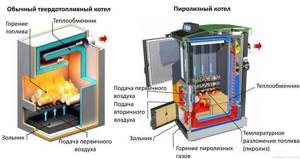
According to the principle of fuel combustion:
- Traditional. They work on wood and coal. The operating principle is the same as that of a conventional wood stove.
- Long burning. Innovative development in the field of heating equipment. Long-burning solid fuel boilers have the form of an elongated combustion chamber surrounded on all sides by a water jacket. When burning, the flame spreads not from bottom to top, but from top to bottom, reminiscent in this respect of the process of burning a candle. The operating principle of a long-burning boiler allows complete combustion of fuel to be achieved. At the same time, the combustion interval of one load of fuel increases (up to 7 days). A long-burning boiler operates, as a rule, at a consistently high coolant temperature, which increases its efficiency by an order of magnitude. The uninterrupted and safe operation of such models is achieved by incorporating fans for emergency extinguishing, a safety valve and a circulation pump into the design.

- Pellet. Special pellets are used as fuel here. Such boilers are additionally equipped with an automatic pellet supply system and a fuel storage bunker. Thanks to electronic sensors, the presence of fuel inside the firebox is monitored. To operate such a system, a stable electrical supply is required.
- Pyrolysis. Unique equipment where, along with the energy from the combustion of solid fuel, the heat release of gases is also used. This makes it possible to convert a small amount of fuel into a significant portion of thermal energy. As a result, an increase in boiler efficiency and a reduction in harmful emissions is achieved.
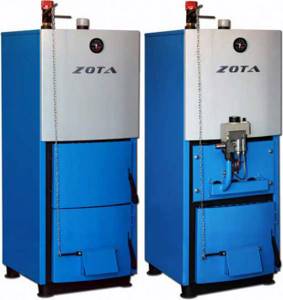
Criterias of choice
Pyrolysis boilers for home heating are designed to operate on different types of fuel: wood, coal, peat, sawdust, pallets. Wood-burning devices have the highest productivity due to complete combustion of fuel in pyrolysis mode. Therefore, if it is possible to inexpensively and in sufficient quantity to prepare firewood for the entire heating season, then you can buy and install just such a boiler at home.
Otherwise, it is better to purchase a universal device that can operate on any solid fuel. Structurally, they are designed in such a way that they can burn up to 80% of fuel resources in pyrolysis mode, and the remaining 20% in the mode of a simple solid fuel unit.
You should also pay attention to:
unit power. When calculating this indicator, the area of the building that will be heated by a long-burning pyrolysis boiler and the level of protection of its rooms from heat loss are taken into account;
volume of the combustion chamber. A boiler with a small combustion chamber will require more frequent fuel supply, so it cannot be left without maintenance for a long time, especially in severe frosts;
quality of the internal coating of the chambers. Chambers with walls lined with ceramic concrete are more protected from burnout, maintain integrity at the maximum heating level and ensure proper combustion of fuel;
the combustion duration with a full load of fuel must be at least 10 hours;
level of automation for device safety. A long-burning pyrolysis boiler must be not only productive, but also safe, so when purchasing, you need to check whether it is equipped with an alarm and an automatic shutdown system;
presence of an additional circuit. A heating device with one circuit can only be used to heat a room. If you plan to use the boiler to organize hot water supply, then you need to immediately buy a device with a dual-circuit design;
price. You should not save on buying a boiler, as cheap models may not have enough technical capabilities for optimal heating of the room. It is better to purchase a boiler from proven brands that have already been tested in harsh Russian winters and have earned good reviews from the owners.
Top combustion boilers
One of the options for a pyrolysis device is an upper combustion boiler. The operating principle of these two units is very similar.
In the same way, a large amount of low-humidity solid fuel is loaded into the firebox, air is forced in and the fuel is allowed to smolder with a reduced amount of oxygen. The valve that regulates the flow of oxygen is installed in the desired position.
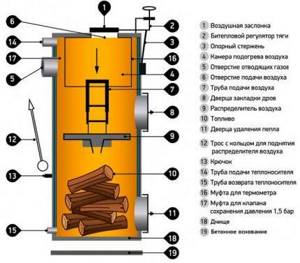
Diagram of a top combustion boiler. The firebox of such a boiler has a solid bottom, particles of combustion products are removed through the chimney (+)
But long-burning boilers have neither an ash pan nor a grate. The bottom is a blank metal plate. Such boilers are designed so that the wood burns completely, and the small amount of ash remaining in the firebox is blown out with air.
Such devices are characterized by high efficiency and also operate at temperatures above 1000°C.
The main feature of such devices is that they really provide a long service life when fully loaded. The fuel chamber in such devices is usually made in the shape of a cylinder.
Fuel is loaded into it from above, and the air necessary for combustion is pumped from above, in the center.
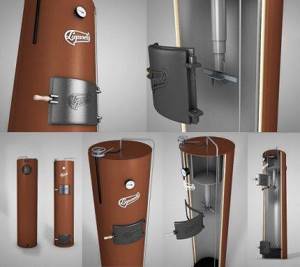
In top-burning boilers, the air injection device is a movable element that moves down as the wood burns
This ensures slow smoldering of the top layer of fuel. The fuel gradually burns, its level in the firebox decreases. At the same time, the position of the device for supplying air to the firebox changes; this element in such models is movable and it practically lies on the top layer of firewood.
The second stage of combustion takes place in the upper part of the firebox, which is separated from the lower compartment by a thick metal disk. Hot pyrolysis gases formed as a result of combustion of fuel below expand and move upward.
Here they mix with air and burn, additionally transferring a significant portion of thermal energy to the heat exchanger.
The beam holding the disk that divides the combustion chamber into two parts, like this disk itself, is constantly under the influence of high temperature during the operation of the top combustion boiler. Over time, these elements burn out and will have to be replaced periodically.
A draft regulator is usually installed at the outlet of the second part of the fuel chamber. This is an automatic device that determines the temperature of the coolant and, depending on the data received, regulates the intensity of movement of the combustible gas. It protects the device from possible overheating.
It is worth noting that the external heat exchanger in such boilers reacts to changes in the speed of liquid circulation in the heat exchanger, i.e. to temperature fluctuations. A layer of condensate immediately forms on the surface of the device, which causes corrosion, especially when it comes to steel boilers.
It is preferable to take a device made of cast iron, which resists such effects much better.
Although fuel in long-burning pyrolysis boilers should burn without residue, in practice this is not always the case. Sometimes the ash cakes, forming particles that are difficult to remove with a stream of air.
If a large amount of such residues accumulates in the firebox, a noticeable decrease in the heat output of the unit may be observed. Therefore, the top combustion boiler should still be cleaned periodically.
The peculiarity of devices of this type is that as the fuel burns, it can be reloaded without waiting for the entire fuel load to burn. This is convenient when you need to get rid of flammable household waste.
There are also varieties of top-burning boilers that run not only on wood fuel, but also on coal. There are no complex automatic control units in pyrolysis boilers of this type, so serious breakdowns are extremely rare.
The design of the top combustion boiler allows the firebox to be loaded only partially, if necessary. However, in this case, igniting the top layer of fuel may not be easy. The fuel itself must be dried; firewood from an open woodpile is not suitable for such a boiler.
Fuel of large fractions should also not be used for this type of equipment, i.e. The wood will have to be chopped into small pieces.
Model overview
The modern market offers many different models of long-burning pyrolysis boilers, differing in a number of technical characteristics, dimensions and price. Pechnoy.guru invites you to check out some good models.
Pyrolysis Master LONGLIFE 18-250 kW
High efficiency, automatic control of the boiler operation and circulation allow this device to effectively perform its functions on one load for 8 - 72 hours (depending on the type of fuel used). The boiler is equipped with a digital controller, an air supply fan, and a 5-pass heat exchanger with a large volume of coolant, ensuring its high performance. The combustion chamber is equipped with water-filled grates and two doors for loading fuel and removing ash residue. The device works equally effectively when manually loading any type of solid fuel into the combustion chamber: coal, briquettes, firewood, sod peat.
Maximum heating area - 18 - 2500 m²;
power - 18 - 250 kW;
Price range depending on power: - 980 - 7300 conventional units.
Buderus Logano S171
The German pyrolysis boiler of this series has an increased volume of the loading section and an improved heat exchanger design and is adapted to work with both natural and forced ventilation of the coolant. Its body is made of high-alloy steel 5 mm thick; fireclay bricks with a longer service life are used for lining the firebox; two ash pan doors, one located on top and the other on the front panel, provide ease of cleaning. The uninterrupted operation of the unit and the protection function are performed by a powerful automatic control system.
How to make a pyrolysis boiler with your own hands
The technological process of manufacturing a boiler based on the pyrolysis operating principle includes plumbing and welding work.
Required materials and tools
To manufacture a high-quality unit, experience in working with the following tools is required:
- electric welding machine;
- electric drill;
- Angle Grinder;
- set of plumbing tools - square, level.
Materials and components required:
- metal: sheet, thickness 4 mm, 7.5 m²;
- pipe - 8 m (diameter 57 mm, wall thickness 3.5 mm);
It automatically performs manipulations with the damper: opening (to increase the combustion temperature) and closing (when the temperature reaches the maximum value)
A temperature sensor is a mechanical device that controls the amount of air flowing into the combustion chamber.
The productivity of the boiler depends on the functioning of the chimney. To ensure good draft, the chimney must meet the quality requirements:
- height not less than 5 meters;
- good insulation;
- no sharp bends;
- condensate drainage;
- easy access for cleaning.
Device drawings and diagrams
A pyrolysis boiler without forced ventilation has the simplest design. The non-volatility of the design reduces the cost of operating the unit.
The diagram of a pyrolysis boiler with a natural smoke exhaust looks like this:
To increase high efficiency, some designs have double base walls
The boiler consists of three main chambers:
- loading room, used for adding fuel;
- an afterburner chamber where secondary air is supplied;
- heat exchanger exiting into the pipe.
The combustion of raw materials directs the gas flow from top to bottom. When air is supplied under the grate into the fireclay brick array, flammable gases are burned. The decomposition products go through the heat exchanger into the chimney. The draft is adjusted by a temperature sensor at the boiler outlet using a chain connected to the secondary air supply damper.
Detailed details with dimensions and tolerances can be found in the standard drawing:
A - boiler circuit controller; B - loading door; C—ash pan cover; D - smoke exhaust; E - coupling for temperature fuse sensor; F - safety valve pipe; G—circuit supply line; H - cold water supply to the heat exchanger; L - return line of the boiler circuit; M - expansion tank
Step-by-step instructions for manufacturing the unit
Making a pyrolysis boiler with your own hands is divided into stages:
- According to the drawing, parts for the body are marked and cut. After “sticking” the elements, a control measurement is made, then welding seams are made. Once in place, the back panel and side walls are welded on both sides, cleaned, and treated with welding sealant.
- The heat exchanger pipes are being installed.
- After welding the outer wall and door shells, a mechanical coolant control regulator is installed.
- The chimney is assembled by extending the pipe. The next part must be inserted inside the previous one so that condensation does not fall on the outside. The finished structure is painted with fireproof paint.
Which company should I buy a solid fuel boiler?
Teplodar
The Russian brand Teplodar was founded in 1997. There is no need to be afraid of its origin; Russian heating equipment is often in no way inferior to foreign products. At the same time, domestic equipment does not need to be imported from abroad, due to which its cost is often quite adequate. The range of solid fuel boilers "Teplodar" cannot be called very wide. But all models comply not only with Russian, but also with global quality standards. You can buy them in almost all major cities of our country.
Buderus

It's hard to believe, but the Buderus brand has existed since 1731. For a long time it belonged to the German company of the same name. In 2003, this company was absorbed by the Robert Bosch GmbH group. However, the brand continued to exist. Now it is managed by the Bosch Thermotechnics division, which has factories including in Russia. Buderus solid fuel boilers show their best side, serving customers for many years.
Protherm

Protherm was founded in Prague in 1991. Its history began with the production of electric boilers. The founders of the company did not at all expect the rapid growth in sales, but it happened - Protherm products became known throughout Europe. This allowed the company to increase production rates and also expand the range, including moving to solid fuel boilers that are gaining popularity. Now all Protherm products receive an EU certificate, which indicates their highest quality.
Viessmann

Many fans of winter sports have at least heard about the German company Viessmann. This brand is actively advertised at biathlon, ski jumping and cross-country skiing competitions. The company was founded in 1917, since then it has not lost its independence for a minute. Almost 8,200 employees ensure the best quality products. Viessmann solid fuel boilers can often last for decades. Their only drawback is the high price - at least in Russian retail.
Wirbel
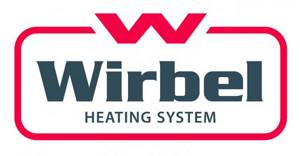
Wirbel boiler equipment appeared on our market relatively recently. However, it quickly gained popularity, as the manufacturer relied on a low price tag and ease of use.
Wirbel solid fuel boilers usually have a steel heat exchanger. The company's product range also includes dual-circuit models. In short, the Russian manufacturer is trying to keep up with its foreign colleagues, while trying to keep the cost at an acceptable level.
Instructions for making a pyrolysis boiler
The most optimal for assembly is a pyrolysis boiler with a capacity of 25 kW or more.
It is capable of heating large rooms with an area of 180 m2. To make it you need the following materials:
- metal sheets with a thickness of at least 0.8 mm;
- 15−20 pieces of fireclay (fireproof bricks);
- temperature sensor system;
- grate;
- 3 pipes with a diameter of 5.7 cm, 3.2 cm and 16 cm (for supplying cold and hot water, as well as for the supply line of the boiler circuit);
- 2 professional pipes (for emergency line and exit pipes);
- blower fan;
- temperature sensor;
- drawing and size table for boiler assembly;
- 2 doors for the firebox and ash pan;
- fastenings made of burnt wire for doors;
- grinding wheels - 10 pieces.
Required tools:
- electric welding machine;
- Bulgarian;
- angle grinder.
Manufacturing process
- It is necessary to cut 4 walls for the boiler from steel sheets. Make holes in the front wall for the firebox and the ash pan located underneath.
- Cut holes for the smoke exhauster and for the pipe pipes. Connect all metal walls (except the back) using a welding machine, and the joints between the sides of the future boiler must be sanded.
- Next, the heat exchanger is assembled, as shown in the figure. The pipes are welded using a welding machine. Before welding, it is necessary to “put on” grinding wheels on the pipes themselves to remove joints and seams between them.
- Then you need to install the heat exchanger into the future boiler as in the figure. Before closing the device with the back wall, it is necessary to check it for leaks with a compressor. If there are none, the back of the boiler is welded.
- Next, you need to install a grate that will separate the place of gasification and fuel combustion. The lower section, where the fuel will be burned, is equipped with an air duct and lined with fireclay (fireproof) bricks on all sides, including the bottom.
- Then you need to attach the doors to the corresponding compartments for the fuel supply and ash pan. They should fit snugly against the walls of the boiler.
- At the end, the finished boiler is installed on a brick surface and connected to a pipe insulated with non-flammable insulation (for example, foil-lined mineral wool). Without this, tar will settle on the pipe walls, which will significantly shorten the service life of the boiler. A water circuit and a smoke pump are connected to the device.
- In order for the boiler to operate automatically, just like a production boiler, it is necessary to install a temperature control system. It is needed in order to regulate the operation of the smoke exhauster, as well as the air supply.
- The installation of the boiler does not end there. It is necessary to check its efficiency. If, after turning on the boiler, you do not detect the smell of carbon monoxide from the smoke coming out, then its efficiency is high enough and the equipment is safe for use.
Thus, if you have initial skills in working with a grinder and a grinder, and if you understand basic drawings, you can easily assemble a pyrolysis boiler yourself. And this is not only comfort and warmth in your home, but also very profitable financial savings.
Pyrolysis boiler size chart
- A-boiler circuit controller
- B - loading door
- Ash door C-door
- D-exhaust exhauster
- E-coupling
- F - emergency line connection
- G - boiler circuit supply line
- H - cold water supply
- K - Hot water supply
- L - Heat circuit return line
- M -Drain pipe and expansion tank
Size table (dependence of the power of the future boiler on the size of the parts).
Cast iron solid fuel boilers with the best reviews
Protherm Beaver 50 DLO
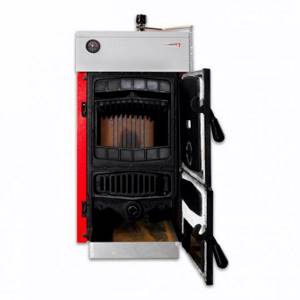
A classic solid fuel boiler supposedly designed specifically for the harsh Russian conditions. If you have encountered such products at least once, you will easily cope not only with operating the device, but also, possibly, with its installation. The maximum thermal power of this model is 39 kW, which is an excellent parameter even for a fairly large house. The efficiency here is also quite good - it reaches 90.2%.
This boiler is single-circuit and its combustion chamber is open. In a word, the engineers tried to make every effort not to complicate the life of the owner of their creation. You can use coal or wood as fuel here. The primary heat exchanger is made of cast iron, which makes it almost eternal. The coolant temperature can reach 85°C. It is recommended to keep the water pressure at 3-4 bar.
Advantages:
- High-quality cast iron heat exchanger;
- The boiler includes a pressure gauge and a thermometer;
- Two types of supported fuel;
- Completely non-volatile;
- Simple mechanical control;
- Relatively simple installation;
- High thermal power.
Flaws:
- The bottom of the boiler gets quite hot;
- Far from the cheapest.
Lamborghini WBL 7
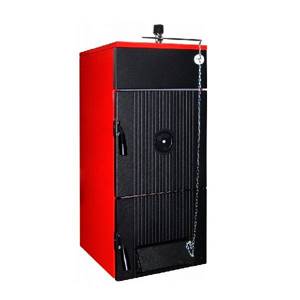
Everyone knows Lamborghini supercars. Some people know that there are tractors under the same brand. But almost none of the Russians suspect that the same Italian company also produces solid fuel boilers. Buying a Lamborghini WBL 7 is a good way to show off to your neighbor. And not so much by the famous brand, but by the capabilities of this device. Its main feature is the ability to switch from solid fuels to gas or diesel fuel. This makes the boiler universal.
The creators tried to ensure that their product performs its function, if not forever, then for at least three to four decades. To do this, they made the heat exchanger cast iron, and also achieved complete energy independence. Everything is fine here with efficiency reaching 90%. None of the competitors discussed below can boast of this! You can’t hear the boiler’s operation even if you are in close proximity—you can thank the well-thought-out sound insulation system for this.
Advantages:
- Made in Italy;
- Belonging to a well-known automobile brand;
- Energy independence;
- Firewood measuring 67 cm fits;
- Power can be adjusted automatically;
- Easy maintenance;
- Minimum noise level;
- Heat exchanger made of cast iron;
- Possibility of using diesel fuel or gas.
The best steel solid fuel boilers
Bosch Sol >
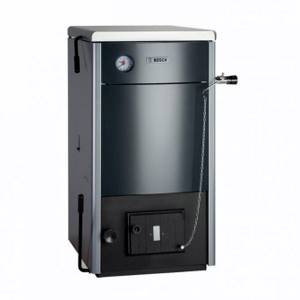
A boiler with an impressive appearance. Its heat exchanger is made of steel, and therefore the weight of the device is not the largest - it does not exceed 155 kg. The boiler is equipped with a pressure gauge and thermometer, thanks to which control is noticeably simplified. Unfortunately, the steel heat exchanger affected the efficiency, which here barely reaches 84%. But Bosch Solid 2000 B SFU 12 is cheaper than its cast iron counterparts.
It is recommended to use coal as fuel here. But you can also use coke, coal or wood briquettes, as well as simple firewood. It’s just that in the case of using the above types of fuel, the thermal power may not be as large as we would like. It should also be noted that the boiler is non-volatile and uses a mechanical control type.
Advantages:
- Different types of fuel can be used;
- Mechanical control;
- The coolant temperature can be increased up to 95°C;
- Does not depend on the availability of electricity;
- Not the heaviest weight;
- Not very high cost;
- There is a thermometer with a pressure gauge.
Flaws:
- Maximum thermal power is only 13.5 kW;
- Low efficiency.
ZOTA Carbon 20
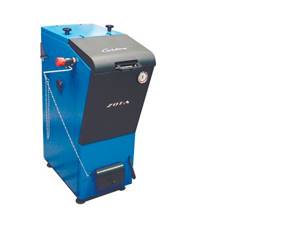
This model got its name in honor of the color of the part of the body, made in carbon style. Like the boilers discussed above, the device is non-volatile and uses an open combustion chamber. Thermal power varies from 7 to 20 kW, which makes it possible to install the boiler in a workshop or in a small country house. You need to load coal or coal briquettes here, depending on your preferences.
The device is capable of raising the coolant temperature to 95°C. To maintain the desired parameter, a heating element is used. Mechanical control does not cause any problems; even an elderly person can handle it.
The only thing you can regret is the efficiency of 80%. But this is the problem with the vast majority of steel models. The 176-kilogram weight of the boiler also causes some sadness - it will require two or even three men to install it.
Advantages:
- Withstands water pressure up to 3 bar;
- A very strong increase in temperature is possible;
- Simple controls;
- Good thermal power;
- It doesn't matter if there is electricity in the house;
- Has a pressure gauge and thermometer;
- Reasonable price tag.
Flaws:
- Only two types of fuel can be used;
- Very low efficiency.
The best long-burning boiler
STROPUVA S40
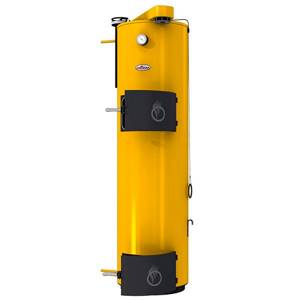
If a boiler is purchased for a workshop, and the manager does not intend to allocate separate personnel to service it, then a special model will be required. For example, STROPUVA S40 might be a good choice. This product belongs to a special class - long-burning boilers. Up to 50 kg of firewood can be loaded into its combustion chamber. They will burn for up to 70 hours - that’s how long you can stay away from the boiler.
Everything is fine with the device and with the thermal power. This parameter reaches 40 kW, which indicates the possibility of heating rooms with a total area of up to 400 m2. In short, this is an excellent industrial design. You can buy it for an ordinary country house, but in this case you must be a wealthy person - the price of the STROPUVA S40 is steep. It is interesting that in all other respects the boiler does not stand out in any way - it is a traditional single-circuit model that uses firewood and wood briquettes to generate heat. The heat exchanger here is steel, and the combustion chamber is open.
Advantages:
- Very high thermal power;
- Relatively small in size;
- Simple controls;
- The fuel burns for a very long time;
- Does not depend on electricity;
- The coolant temperature can reach 95°C;
- There is a safety valve.
Flaws:
- Only wood is suitable as fuel;
- Efficiency - only 85%;
- Weight reaches 291 kg;
- Scary cost.
Top loading boiler design
Top-loading heating equipment has a design similar to a candle. A solid fuel boiler of this type has a vertically standing body in the shape of a cylinder. The vertical arrangement is determined by the principle of operation of the unit; moreover, the housing in this device is two-layer, playing the role of a heat exchanger. Boiler water circulates between the outer and inner walls from top to bottom, receiving heat as a result of the combustion of pyrolysis gas.

* The operating principle also determines the location of the loading chamber. Above it there is an air heating chamber, through which the air distributor moves up and down. At the bottom of the apparatus there is an ash pit, a place where the minimum amount of combustion residues enters.
At the moment, manufacturers produce long-burning solid fuel devices in two versions:
- units that consume firewood and fuel briquettes;
- devices running on coal, wood and fuel briquettes.
In most cases, manufacturers declare the duration of the boiler operation from one load directly in the technical documentation for the heating boiler. As a rule, these periods vary from 24 to 48 hours when working with wood and briquettes, to 3-5 days when loading the boiler with coal.
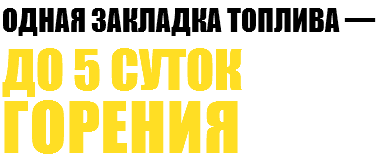
For reference: The duration of combustion of a fuel material is largely influenced by the quality of the fuel. Firewood made from hard wood (birch, oak, beech, ash) burns for a long time, releasing a large amount of heat. Coniferous wood burns more intensely; therefore, the operating life of a boiler using pine wood will be significantly shorter.
In addition to firewood, briquettes and coal, secondary wood products can be used to operate this type of heating device. When choosing the type of fuel resource, it is necessary to take into account its availability. A single load will require up to 30-50 kg of finished fuel. The boiler power determines the stack height. In different models this parameter varies between 600-1500mm. As for power, the spread of parameters is even greater. Today, boilers for autonomous heating are produced with a capacity of 8,10,20 and 40 kW.
Top loading heater control system
The issue regarding the principle of operation of the boiler and the loading method has been sorted out. Everything here is clear and accessible. Let's look at what the control system for such equipment looks like next. In long-burning boilers, the main control principle is based on regulating the air flow entering the combustion chamber. Models that are conventional units have a mechanical device for adjusting air masses. A conventional chain-driven damper is activated by the operation of a thermostat. However, this method has one critical technical drawback.
The thermostat is set to a specific temperature. When the coolant is heated to a certain temperature, the damper takes a certain position, reducing the intensity of combustion. It is not possible to achieve a sharp decrease in temperature due to the high inertia of the operating unit. By inertia, the coolant will continue to heat up for some time, working for the heating system.
A similar operating principle is associated with increasing the boiler water heating temperature. Until the boiler reaches rated power, the coolant temperature will rise very slowly.

*
The situation is different with units that are equipped with a fan. The electric device pumps air when necessary, increasing the combustion intensity. Due to the air blower, it is possible to reduce the inertia of long-burning heating equipment. Turning the supercharger on and off is controlled automatically, which is equipped with sensors that record the slightest changes in coolant temperature.
If technologically necessary, the fan can be stopped, leaving smoldering fuel on a meager oxygen supply. Air will enter the firebox naturally. Such a scheme allows you to reduce the temperature of the coolant during breakthrough, a phenomenon that is caused by inertial processes in the operation of the heating unit.
Note: it will take from 0.5 to 1 hour for the heating boiler to return to normal operation. If you want to turn off the heating, the expansion tank connected to a single heating circuit is switched on. With the help of a tank, excess heat coming from the cooling boiler is compensated. The time for a long-burning solid fuel boiler to completely cool can be 2-5 hours.
The best pyrolysis solid fuel boiler
Buderus Logano S121-2-32
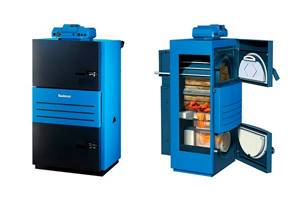
An excellent boiler from a division owned by Bosch. The power of the product reaches an impressive 32 kW. But to achieve this parameter you will have to spend a large amount of fuel, since the efficiency here is extremely low - it is only 78%. Electronic control can also slightly strain the buyer, because of which the boiler requires constant availability of electricity (it is connected to a single-phase network).
The device displays all the most important parameters on a digital display - on it you can see temperature and pressure. The boiler also includes an open combustion chamber. The heat exchanger is steel, but this has not reduced the weight - the total mass of the boiler, together with its 150 mm chimney, reaches 375 kg. The buyer should be pleased with the exhaust fan - it is present here, and its operation is almost inaudible.
Advantages:
- High coolant temperature;
- Easy to understand controls;
- Exhaust fan;
- Withstands high pressure in pipes;
- Modern technologies are used;
- High thermal power.
Flaws:
- Eats only firewood;
- Very heavy;
- Extremely low efficiency;
- Almost the maximum cost;
- Not non-volatile.
Budget solid fuel boiler with the best reviews
EVAN WARMOS TT-25K
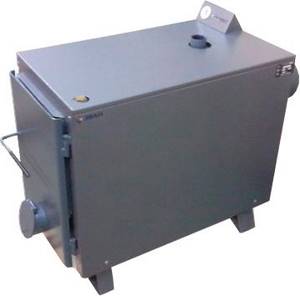
This relatively inexpensive boiler is made according to classical principles. It is of a single-circuit type, its combustion chamber is open, and the heat exchanger is made of steel. And don’t be confused by the low efficiency - a 2 kW heating element helps to partially save the energy obtained from fuel combustion.
This boiler heats up the maximum coolant to a temperature of 95°C. It is allowed to use peat, coal and, of course, firewood as fuel. Depending on the fuel used, the thermal power can vary from 8 to 25 kW. Theoretically, EVAN WARMOS TT-25K can heat a room with an area of 180 m2, which is a very good indicator. One can’t help but rejoice at the complete energy independence and mechanical control.
Advantages:
- Powerful heating element included;
- Withstands decent water pressure;
- Simplest controls;
- Heats very large rooms;
- It is inexpensive;
- Does not depend on electricity;
- Different types of fuel;
- Minimum weight (125 kg);
- It is possible to stack 55 cm firewood;
- There is both a pressure gauge and a thermometer.
Flaws:
- Efficiency - only 75%;
- The fuel burns fairly quickly;
- Not very high reliability.
Some manufacturers and characteristics of their boilers
We give examples of modern devices of Lithuanian, Ukrainian and Polish production.
Lithuanian boilers “Stropuva”
They are produced in three modifications. The first of them is Stropuva S7, S10, S20, S40. These are devices for working with wood, wood waste and fuel briquettes. The duration of continuous combustion reaches thirty hours.
The heated area ranges from 20 – 80 m2 for a 7 kW boiler (Stropuva S7). The Stropuva S40 boiler, whose power is 40 kW, will heat up to 200 - 400 m2.
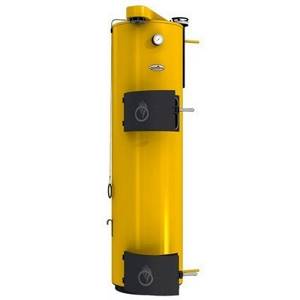
Boiler "Stropuva"
The second model is Stropuva S10U, S20U, S40U (station wagon). These are devices that operate on both coal and firewood, wood waste and fuel briquettes. Such top-burning boilers will be able to heat rooms with an area of 50 – 100 m2.
Stropuva S10U with a power of 10 kW has this capability. Stropuva S40U station wagon will provide heat up to 200 – 400 m2 of area. The operating time is up to five days.
The third option is boilers Stropuva S20 – I IDEAL, S40 – I IDEAL. In addition to the previous types of fuel, they can also operate on pellets. The design of the products includes a microprocessor temperature controller (programmer) and a centrifugal fan.
Features of work
The programmer controls the operation of the boost fan and circulation pump of the heating system. It has four operating modes: standby, ignition, operation, support. This allows the consumer to set the desired temperature.
There is no longer any need to be distracted by monitoring work until the next fuel load. The programmer is equipped with an emergency indicator that signals the user about deviations from normal operation.
Ukrainian "Buran"
For domestic needs, single-circuit and double-circuit top-burning boilers are produced. Single-circuit ones are intended only for heating premises with wood and its waste.
The power of such devices is 12, 20, 40 kW (an example of marking is “Buran 40”). Universal options (labeled, for example, “Buran 40U”) of the same power can also use coal in addition to firewood.
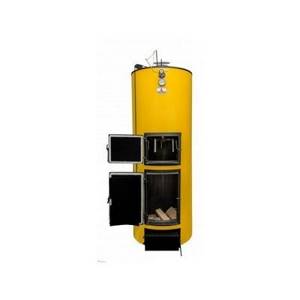
Boiler "Buran"
Double-circuit units are used for space heating and hot water preparation. Their power can be 12, 20, 40 kW. These boilers have a built-in coil made of copper tubing.
The efficiency of such boilers reaches 86%. One load of firewood is enough for 12-24 hours of work. This depends on the density of their laying and specific operating conditions, and for coal - up to five days. The heated area for all devices ranges from 100 to 450 m2 depending on the power.
Which solid fuel boiler to choose
1. In this article we tried to talk about a wide variety of boilers. All of them are united only by the fact that they are primarily designed to work with solid fuel. All you have to do is pay attention to the remaining parameters. For example, the material of the heat exchanger determines how much fuel will be burned in vain, as well as the service life of the boiler. The volume of the combustion chamber is also a very important parameter, which indicates how often it is necessary to approach it to load a new portion of fuel.
2. It is impossible to recommend a specific model for purchase. It all depends on what kind of rooms you are going to heat. It is necessary to take into account even the material from which the structure is made, as well as its dilapidation! You also need to take into account the natural conditions that occur in your region in winter.
